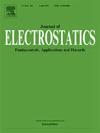Design, development and performance evaluation of a miniature electrostatic precipitator in an indoor environment
IF 1.9
4区 工程技术
Q3 ENGINEERING, ELECTRICAL & ELECTRONIC
引用次数: 0
Abstract
Indoor air quality is a major concern in the modern environment. Although various pollutants coexist indoors, particulate matter (PM) is a major health concern. Even though different PM capture technologies are available in market as well as on lab scale, they pose several drawbacks. It was in this regard that electrostatic precipitator (ESP), a widely preferred technology for industrial application but has yet to be explored to that extent in indoor environments could provide multiple benefits in latter. Therefore, a miniature single-wire, single-stage and wire-plate square cross-sectional ESP was designed in laboratory and operated at optimal operating conditions based on theoretical calculations, experimental results as well as computational fluid dynamics (CFD) modelling to obtain maximised capture of PM. Results from study confirmed that designed ESP was capable of capturing various standard aerosols such as sodium chloride, ammonium chloride and magnesium chloride with a total removal efficiency of 99.94 %–99.97 % in wide PM sizes from 10 nm to 800 nm. To simulate performance in a real scenario, experiments were also performed with major indoor PM sources like incense sticks, candle burning and mosquito coils having different particle number distributions and achieved a total PM capture efficiency of 99.24, 99.99 and 99.97 % respectively. Designed ESP also removed ambient air as well as infiltrated PM from outdoors with a total efficiency of 97.87 % and 99.74 % respectively. Additionally, energy consumed/clean air delivery rate (CADR) (0.32 W/(m³/hr)) and emission of by-products like ultrafine particles as well as nitrogen dioxide were found to be comparatively lesser compared to commercial purifiers suggesting its possible applicability in scaling up as an indoor air purifier.
室内微型静电除尘器的设计、研制及性能评价
室内空气质量是现代环境中的一个主要问题。虽然室内存在多种污染物,但颗粒物(PM)是一个主要的健康问题。尽管市场上和实验室规模上都有不同的PM捕获技术,但它们存在一些缺点。在这方面,静电除尘器(ESP)是工业应用中广泛采用的技术,但在室内环境中尚未探索到这种程度,它可以为后者提供多种好处。因此,在实验室中设计了一种小型单线、单级、线板方形截面ESP,并根据理论计算、实验结果以及计算流体动力学(CFD)建模,在最佳工况下运行,以最大限度地捕获PM。研究结果证实,设计的ESP能够捕获各种标准气溶胶,如氯化钠、氯化铵和氯化镁,总去除率为99.94% - 99.97%,粒径为10 nm至800 nm。为了模拟真实场景的性能,我们还对不同颗粒数分布的室内主要PM源如熏香、蜡烛燃烧和蚊香进行了实验,PM的总捕获效率分别为99.24%、99.99%和99.97%。设计的电潜泵还能去除室外的环境空气和渗透的PM,总效率分别为97.87%和99.74%。此外,与商用净化器相比,能耗/清洁空气输送率(CADR) (0.32 W/(m³/hr))和副产物(如超细颗粒和二氧化氮)的排放相对较少,这表明它可能适用于扩大室内空气净化器的规模。
本文章由计算机程序翻译,如有差异,请以英文原文为准。
求助全文
约1分钟内获得全文
求助全文
来源期刊

Journal of Electrostatics
工程技术-工程:电子与电气
CiteScore
4.00
自引率
11.10%
发文量
81
审稿时长
49 days
期刊介绍:
The Journal of Electrostatics is the leading forum for publishing research findings that advance knowledge in the field of electrostatics. We invite submissions in the following areas:
Electrostatic charge separation processes.
Electrostatic manipulation of particles, droplets, and biological cells.
Electrostatically driven or controlled fluid flow.
Electrostatics in the gas phase.
 求助内容:
求助内容: 应助结果提醒方式:
应助结果提醒方式:


